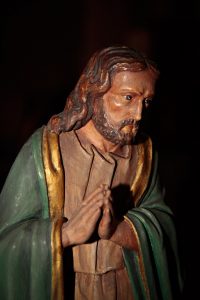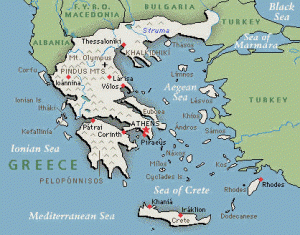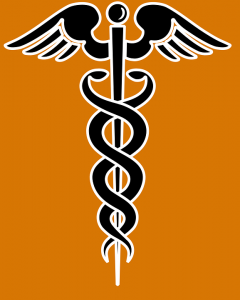We have often engaged in discussions of various aspects of the New (Christian) Testament of the Bible; in fact, most of the posts in the Past category have something to do with either the Christian Testament or the social context of the early Jesus movement. We have pointed out the important role of women in the Graeco-Roman world and in St. Paul’s circles, and we have promoted the use of archaeology in uncovering evidence for non-elite persons during that era. We have attempted to show how interesting these findings are in and of themselves, and also how important they are even for us today.  Western culture is heavily dependent upon the early church, and scholarly evidence shows incontrovertibly that women should never have been relegated to second-class citizenship: they were not so relegated in the Jesus movement, despite what tradition has led us to believe. Furthermore, again contrary to the persistent narrative, there is evidence that early Jesus followers honored same-sex relationships.
Western culture is heavily dependent upon the early church, and scholarly evidence shows incontrovertibly that women should never have been relegated to second-class citizenship: they were not so relegated in the Jesus movement, despite what tradition has led us to believe. Furthermore, again contrary to the persistent narrative, there is evidence that early Jesus followers honored same-sex relationships.
Here we will give an overview of what might be termed “New Testament 101” in a college or seminary course – the basics of the Christian Testament writings that have been read and revered by millions since the first century of the Common Era (CE). (Note that this treatment will constitute only the tip of the iceberg of all the competent research in this and related fields.) Even if you might not be a Christian or an otherwise religious person, and even if you have little interest in this field or this information, we encourage you to read on – because a literal reading of the Bible, which still exists in 21st-century America, often poses real dangers to our society.
The Canonical Writings
If you do not have access to a Bible, you can find the Table of Contents of the Christian Testament here. There are 27 books in the so-called “canon,” categorized into Gospels (4) about the life and teachings of Jesus of Nazareth, Acts of the Apostles, Letters or Epistles (21) and the Revelation of John.  This canon took several centuries to establish, and one can argue that the official books of the Bible used by Christians are still in flux.
This canon took several centuries to establish, and one can argue that the official books of the Bible used by Christians are still in flux.
All of these Christian Testament texts were originally written in Greek. They are preserved in thousands of manuscripts that have been preserved around the world, many of them in translations in an array of languages; the manuscripts, often lavishly illustrated and sometimes quite fragmentary, were copied by hand by monks and nuns in rather dark monasteries. This, of course, impacts such issues as dating, translation and theological interpretation, which we examined earlier.
Contrary to what might be assumed by the ordering of the Christian Testament texts in the Bible (an ordering that took place in the Middle Ages), the earliest writings – and thus those closest to the time of Jesus of Nazareth – were not the Gospels but the authentic letters of St. Paul. And, contrary to traditional understanding, not all the letters deemed “of Paul” in many Bibles (e.g., the revered King James Bible of 1611) were written or dictated by Paul.
In the mid-19th century, German scholar F.C. Baur determined that Paul did not write all the letters attributed to him, and Baur’s conclusions have stood the test of time through the research of many other experts. Unfortunately, this scholarly consensus is not respected by all Christians. As can be found in the mission statements of countless Fundamentalist churches and denominational centers across the US, the Bible is understood to be the “inerrant Word of God,” to be taken literally. (Additional tenets of literalist Christians include belief in “the imminent and physical Second Coming of Jesus Christ, and Christ’s Virgin Birth, Resurrection, and Atonement.”) ![]() Below we will show why this stance can be of grave concern for Americans in this moment.
Below we will show why this stance can be of grave concern for Americans in this moment.
For now, let us summarize the scholarly consensus about Paul’s letters. Twelve or 13 letters have traditionally been attributed to him, but only seven are deemed authentic, written between 50 and 60 CE:
- Romans
- I Corinthians
- II Corinthians
- Galatians
- Philippians
- I Thessalonians
- Philemon
The authenticity of these seven is determined by dating, which is in turn determined through internal and external evidence. Historians estimate Paul’s death at between 64 and 68 CE. Letters long attributed to Paul – Colossians, Ephesians, II Thessalonians, I and II Timothy, and Titus – were actually written and circulated after Paul’s death (some written perhaps as late as 150 CE). This is important not only from the perspective of accuracy but also because the theological perspectives of the non-Pauline writings are different from those of the genuine Pauline letters. One major difference, for instance, which concerns the role of women (discussed earlier), is found in the so-called Household Codes of Colossians, Ephesians, I Peter, I Timothy, and Titus.
The authentic Pauline letters, then, more accurately reflect the earliest communities of Jesus followers than any other Christian Testament text. This means that the Gospels were written and circulated not only after Jesus died (ca. 30 CE) but after Paul died as well. Scholars as long ago as the mid-19th century postulated that the Gospel of Mark was the first to be written, probably around 70 CE (Koester, “Literature,” 551-56). Matthew and Luke have similarities to Mark (with John being significantly different), so scholars consider these three as “synoptic” (from Latin synopticus and Greek συνοπτικός, meaning “seeing all together”).
 Matthew and Luke copied much of Mark, with Matthew being composed between 80 and 90 CE and Luke between 80 and 100 CE. [] Similarities between Matthew and Luke may have derived from a written or oral source dubbed Q by scholars (Q comes from the German word Quelle, meaning source). The Gospel of John may have had its origins around the same time as Mark but did not come into its final form until closer to 100 CE. While tradition maintains that the authors of the Gospels were men who knew Jesus and may have been among his disciples, that theory has been discredited. Matthew “was likely penned by an unknown author within a Jewish-Christian community,” and Luke was most likely composed anonymously by either “a Gentile Christian with admirable knowledge of Jewish tradition [or] a Hellenized Jew residing outside of Palestine.”
Matthew and Luke copied much of Mark, with Matthew being composed between 80 and 90 CE and Luke between 80 and 100 CE. [] Similarities between Matthew and Luke may have derived from a written or oral source dubbed Q by scholars (Q comes from the German word Quelle, meaning source). The Gospel of John may have had its origins around the same time as Mark but did not come into its final form until closer to 100 CE. While tradition maintains that the authors of the Gospels were men who knew Jesus and may have been among his disciples, that theory has been discredited. Matthew “was likely penned by an unknown author within a Jewish-Christian community,” and Luke was most likely composed anonymously by either “a Gentile Christian with admirable knowledge of Jewish tradition [or] a Hellenized Jew residing outside of Palestine.”
Traditional Christianity also leans heavily on the stories told in the Acts of the Apostles, which tells tales about the growth of the Jesus movement and Paul’s supposed missionary travels around the Mediterranean. While Paul discusses his travels to some extent in his letters, the information is limited. Thus tradition uses Acts to fill in the gaps; the elaborate maps of Paul’s travels one sees in churches, books, etc. are based primarily on Acts. Unfortunately, scholars that have studied Acts extensively believe that the book should be regarded more as a combination of genres, and certainly not as history as we understand it (Koester, “Literature,” 555). While there are historically accurate aspects of Acts – locations, for instance – it is largely fictitious, written mainly “to counter possible hostility from the Roman government” and to legitimize the Christian movement (Cadbury, 37). If Acts was ultimately published/circulated around 115 CE (Pervo, 346), this is two to three generations removed from the time of Jesus’ disciples and Paul’s life. Understanding Acts as an historically accurate account is misleading and irresponsible.
The final book of the Bible is the Revelation (or Apocalypse) of John, a very complex work that has taxed many a scholar and reader since it began circulating around 90-95 CE. There are a myriad of responsible analyses of this book, which was concerned primarily with the Christian struggle within the context of the Roman Empire (Schüssler Fiorenza, “Revelation, Book of,” 745). However, in the past few decades the Christian right has popularized it in significant ways. Revelation (singular, no “s” on the end) was the focus of the Left Behind series of books and a movie and the best-selling The Late Great Planet Earth by the late evangelical Hal Lindsey. These works represent the belief on the part of many Christians in the Fundamentalist vein “that the rapture and the seven-year tribulation [Rev 7:14 and elsewhere in the Bible] are clearly taught in the Bible, that we are in the end times in our era, and that the Book of Revelation is a terrifying prediction of events that are happening in our day.” What makes these rather odd beliefs so alarming is that they have led to real consequences, e.g., a distorted and prejudiced view of Islam after September 11th and the fear of subjection to Europe and a Communist take-over.
Other Texts and Literature Relevant to Nascent Christianity
The Christian Testament, as revered and readily available as its texts are, is only a small sampling of writings about the Jesus movement that circulated in the first 300 years of the Common Era. The invention of the codex in the second century CE greatly aided in the spread of writings about Jesus (Peters, 502). Some of this ancient literature was known to the early Church Fathers, which is often the only way we know about them, and the Fathers could be highly critical, complaining that the texts and those who revered them were “heretical.” For this reason, the established Church disparaged them, did not feel they added anything to the Christian faith, and effectively prevented clerical and laypeople from reading and studying them.
 Two major finds significantly changed this trajectory: the discoveries of the Dead Sea Scrolls in 1947 in the Judean wilderness beside the Dead Sea and the Nag Hammadi library in 1945-46 in Egypt. The Dead Sea Scrolls are generally Jewish documents so do not concern literalist Christians too much. The same cannot be said, however, about the Nag Hammadi library. This collection is comprised primarily of Christian writings in Coptic from the fourth century. Studies of the texts have consumed mainstream scholars since their discovery and have yielded a great deal of information about non-orthodox Christian groups and their thinking (originally described as Gnostic). The library “is not only of inestimable importance for the content of the many lost Greek works it has preserved in Coptic translation [but] also sheds significant light upon the production of the books themselves and hence upon those copied and buried them” (Robinson, 10).
Two major finds significantly changed this trajectory: the discoveries of the Dead Sea Scrolls in 1947 in the Judean wilderness beside the Dead Sea and the Nag Hammadi library in 1945-46 in Egypt. The Dead Sea Scrolls are generally Jewish documents so do not concern literalist Christians too much. The same cannot be said, however, about the Nag Hammadi library. This collection is comprised primarily of Christian writings in Coptic from the fourth century. Studies of the texts have consumed mainstream scholars since their discovery and have yielded a great deal of information about non-orthodox Christian groups and their thinking (originally described as Gnostic). The library “is not only of inestimable importance for the content of the many lost Greek works it has preserved in Coptic translation [but] also sheds significant light upon the production of the books themselves and hence upon those copied and buried them” (Robinson, 10).
However, the Roman Catholic Church and more Fundamentalist Protestant denominations seem not to appreciate this wealth of information, often tending to disparage these texts (even though many of the scholars involved with the Nag Hammadi manuscripts have been Roman Catholic). The disregard for this rich trove of evidence pertaining to the history of Christianity is unfortunate, at the very least, and misleading to anyone curious about them.
One of the many texts from Nag Hammadi that is particularly significant for Christian Testament studies is a version of the Gospel of Thomas. Unlike the canonical Gospels, GospTh is a collection of 114 sayings, parables, etc. attributed to Jesus, and fragments of the document have been found elsewhere.  Scholars surmise that it was composed possibly as early as the second half of the first century, probably in Syria, with roots even earlier. Because the sayings closely resemble many found in the Synoptic Gospels – those designated as “Q” – GospTh adds considerably to our knowledge of the early Jesus movement (Koester and Lambdin, 117). Again, though, it is widely dismissed or criticized by literalist Christians.
Scholars surmise that it was composed possibly as early as the second half of the first century, probably in Syria, with roots even earlier. Because the sayings closely resemble many found in the Synoptic Gospels – those designated as “Q” – GospTh adds considerably to our knowledge of the early Jesus movement (Koester and Lambdin, 117). Again, though, it is widely dismissed or criticized by literalist Christians.
Other texts and documents circulated in the first centuries of the Common Era among the many communities that followed the teachings of Jesus in one way or another. We have examined this so-called apocryphal literature earlier. These texts include a wide variety of Gospels, Acts, apologies, aretologies, letters, wisdom books, church orders, treatises, and so on (Koester, “Literature,” 552-53). For liberal and mainstream scholars, this is a gold mine of exciting and interesting data that can be endlessly studied. However, because Fundamentalists believe that the biblical texts are the Word of God, texts that did not make it into the canon are much less worthy to be considered. This stance can give inquirers an unfortunate bias against what can be learned – and what has been learned – from them.
The Dangers of Literalism Today
Let us be clear: Christians who believe the Bible, or especially the Christian Testament, to be the literal Word of God are not bad people. However, Christian literalism as a belief system is dangerous at many levels in modern American society as we try valiantly to thwart totalitarianism and preserve our democratic republic.
- Believing that religious documents written in a foreign language two thousand years ago in a pre-industrial context – in a number of different geographic areas – supersede modern understandings of the human condition in almost every way has led to a non-critical, often anti-intellectual, understanding of our world.
 One example of this is the efforts on the part of school systems in many parts of the country that are attempting to replace study of the theory of evolution with so-called Intelligent Design. Disinformation constantly pumped out via social and other media about the evils of fellow Americans who think differently than they – such as the legitimacy of other religions and political stances – has in turn led to political violence and even death.
One example of this is the efforts on the part of school systems in many parts of the country that are attempting to replace study of the theory of evolution with so-called Intelligent Design. Disinformation constantly pumped out via social and other media about the evils of fellow Americans who think differently than they – such as the legitimacy of other religions and political stances – has in turn led to political violence and even death. - The unquestioned belief that there is only one way to worship God – e.g., that anyone who does not believe that “Jesus Christ is my Lord and Savior and anyone who doesn’t is condemned to hell” – has led to the growing American narrative that any suggestion of difference is “woke,” anti-American, socialist or communist. This one “brand” theory of Christianity is completely unhistorical: there was great variety in the early Jesus communities (Robinson and Koester, 10-16, for instance), and it is not for us (or the powerful male hierarchy in the Byzantine era) to decide that those were illegitimate.
- The anti-scientific Christian narrative such as the objection to using cell lines derived from aborted fetuses in vaccine development, or the long-discounted but recently-resurrected theory that vaccines cause autism, are leading to many preventable deaths, in the case of measles, and inexcusable family anguish, in the case of autism.
 These beliefs have also led to cowardly Republican Senators permitting anti-vaccine warrior and conspiracy theorist Robert F. Kennedy, Jr., to be confirmed as Secretary of Health and Human Services.
These beliefs have also led to cowardly Republican Senators permitting anti-vaccine warrior and conspiracy theorist Robert F. Kennedy, Jr., to be confirmed as Secretary of Health and Human Services. - The persistent insistence that Paul wrote “Wives, be subject to your husbands” (Eph 5:22, Col 3:18) and “I permit no woman to teach or to have authority over a man” (1 Tim 2:12) has led for centuries to the suppression of women in church and society. Not only did these phrases emerge after Paul’s death but the reality is that Paul had great respect for women and had women leaders in his several missionary circles; 10 women are mentioned in Romans 16, for instance, including an apostle and a deacon. If today’s Christians are looking to the earliest documents of the Jesus movement for instruction on how women should be treated, they must be honest and look to the authentic letters of Paul.
- Similarly, literalist-based homophobia, legislation against citizens who are not heterosexual, and violence against members of the LGBTQ+ community are completely illegitimate according to the Christian Testament texts. Anti-gay passages throughout the Bible are taken out of context by literalists; by contrast, explicit passages – e.g., Phil 4:2-3 and Rom 16:3-4 – show clearly that same-sex relationships were honored, not disparaged, in early Christian sources.
 Even as late as the Byzantine era, same-sex couples were buried together on church property.
Even as late as the Byzantine era, same-sex couples were buried together on church property. - The ire of the Christian right against the social justice thrust of more liberal Christianity misses much of the message of Jesus. Historical analyses of the early Jesus movement – both the canonical texts and many that were revered by communities but do not appear in the Bible – stress Jesus’ love, mercy, forgiveness, inclusiveness and justice. The twisting of Jesus’ message to advocate misogyny, racism, attacks on law-abiding immigrants and refugees (of which Jesus and his family were among), the abolition of women’s reproductive health care services, and exploitation of the poor by the very wealthy is totally contrary to the evidence. The message-twisting, in the name of Jesus or God, has tragic consequences for millions of us.
Connecting the dots between Christian literalism and negative social results – legislation, attitudes, and especially violence – is incumbent on all of us: not only religious leaders of all stripes, and religious laypeople, but also journalists, elected officials, politicians, teachers, professors, activists, voters and everyday citizens.  Those of us who comprise the Democracy Coalition can no longer cling to a “fair-and-balanced” position, as much as we might want to; beliefs lead to actions, and dangerous, uninformed beliefs lead to dangerous results.
Those of us who comprise the Democracy Coalition can no longer cling to a “fair-and-balanced” position, as much as we might want to; beliefs lead to actions, and dangerous, uninformed beliefs lead to dangerous results.
The scholarly evidence in Christian Testament studies is completely accessible (see list below and embedded web references above); there is no excuse in this day and age to close our eyes to facts, evidence and truth when it comes to our very survival and our pursuit of a “more perfect union.”
————————————————————–
A Selection of Resources for Further Reading
Basic information about the Christian Testament can be found in many commentaries that have been published over the past century. (Caution: publishers such as Baker, InterVarsity Press, Zondervan, Tyndale House Publishers, and Wycliffe tend to write more in the evangelical, if not Fundamentalist, vein. Publishers such as Wm. B. Eerdmans Publishing Company, Westminster John Knox, Pilgrim Press, and Hermeneia Press are more mainstream/liberal.)
Abrahamsen, Valerie. “Human and Divine: The Marys in Early Christian Tradition,” in Amy-Jill Levine with Maria Mayo Robbins, eds., A Feminist Companion to Mariology, 164-81. London and New York: T & T Clark International, 2005.
Abrahamsen, Valerie. “Priestesses and Other Female Cult Leaders at Philippi in the Early Christian Era” in Joseph A. Marchal, ed., The People beside Paul: The Philippian Assembly and History from Below, 25-62. Atlanta, GA: SBL Press, 2015.
Abrahamsen, Valerie. “St. Paul and Goddesses along the Via Egnatia: Paganism and the Early Jesus Movement in Ancient Macedonia,” The Independent Scholar, Vol. 9, https://www.ncis.org/the-independent-scholar/tis (December 2022) 40-55.
Abrahamsen, Valerie A. Women and Worship at Philippi: Diana/Artemis and Other Cults in the Early Christian Era. Portland, ME: Astarte Shell Press, 1995.
Abrahamsen, Valerie. “Women at Philippi: The Pagan and Christian Evidence,” Journal of Feminist Studies in Religion, Vol. 3, No. 2 (Fall 1987) 17-30.
Bauer, Walter. Orthodoxy and Heresy in Earliest Christianity. Ed. Robert A. Kraft and Gerhard Krodel; Philadelphia: Fortress, 1971; German original, Rechtglaubigkeit und Ketzerei im altesten Christentum. Tübingen: Mohr/Siebeck, 1934.
Borg, Marcus J. The Heart of Christianity: Rediscovering a Life of Faith. New York: HarperCollins Publishers, 2003.
Borg, Marcus J. Meeting Jesus Again for the First Time. New York: HarperSan Francisco, 1995.
Borg, Marcus J. and John Dominic Crossan. The Last Week: What the Gospels Really Teach About Jesus’s Final Days in Jerusalem. New York: HarperCollins Publishers, 2006.
Brooten, Bernadette. Women Leaders in the Ancient Synagogue, Brown Judaic Studies no. 36, Chico, CA, 1982.
Bultmann, Rudolf. Theology of the New Testament. New York: Charles Scribner’s Sons, 1951 (Vol. 1), 1955 (Vol. 2).
Buttrick, George Arthur, ed. The Interpreter’s Dictionary of the Bible: An Illustrated Encyclopedia. Nashville and New York: Abingdon Press, 1962.
Cadbury, Henry Joel. “Acts of the Apostles,” in George Arthur Buttrick, ed., The Interpreter’s Dictionary of the Bible: An Illustrated Encyclopedia, Vol. 1, 28-42. New York and Nashville: Abingdon Press, 1962.
Cartlidge, David R. and J. Keith Elliott. Art and the Christian Apocrypha. London and New York: Routledge, 2001.
Crossan, John Dominic. The Birth of Christianity. New York: HarperCollins Publishers, 1998.
Crossan, John Dominic. Jesus: A Revolutionary Biography. New York: HarperSanFrancisco, 1994.
Crossan, John Dominic and Jonathan L. Reed. Excavating Jesus: Beneath the Stones, Behind the Texts. New York: HarperCollins Publishers, Inc., 2001.
Crossan, John Dominic and Jonathan L. Reed. In Search of Paul: How Jesus’s Apostle Opposed Rome’s Empire with God’s Kingdom. New York: HarperSanFrancisco, 2004.
Kampen, Natalie. Image and Status: Roman Working Women in Ostia. Berlin: Gebr. Mann Verlag, 1981.
Kateusz, Ally. Mary and Early Christian Women: Hidden Leadership. London: Palgrave Macmillan, 2019.
Kirby, Peter. The “Early Christian Writings: New Testament, Apocrypha, Gnostics, Church Fathers” website, copyright © 2001-2005, https://www.earlychristianwritings.com/.
Koester, Helmut. Ancient Christian Gospels: Their History and Development. London: SCM Press Ltd. and Philadelphia: Trinity Press International, 1990.
Koester, Helmut. Introduction to the New Testament. Volume Two: History and Literature of Early Christianity, second ed. New York: Walter de Gruyter, 1982, 2000.
Koester, Helmut. “Literature, Early Christian,” The Interpreter’s Dictionary of the Bible, Supplementary Volume, 551-56. Nashville: Abingdon, 1976.
Koester, Helmut and Thomas O. Lambdin. “The Gospel of Thomas,” in James M. Robinson, ed., The Nag Hammadi Library, 117-30. New York: Harper & Row, Publishers, 1977.
Kraemer, Ross Shepard and Mary Rose D’Angelo, eds. Women and Christian Origins. New York and Oxford: Oxford University Press, 1999.
Lefkowitz, Mary R. and Maureen B. Fant. Women’s Life in Greece and Rome. Baltimore: Johns Hopkins University Press, 1982.
Levine, Amy-Jill, ed. “Women like This:” New Perspectives on Jewish Women in the Greco-Roman World. Atlanta, GA: Scholars Press, 1991.
Levine, Amy-Jill and Marc Zvi Brettler, eds. The Jewish Annotated New Testament: New Revised Standard Version Bible Translation. New York: Oxford University Press, Inc., 2011.
MacRae, George. “Nag Hammadi,” The Interpreter’s Dictionary of the Bible, Supplementary Volume, 613-19. Nashville: Abingdon, 1976.
Metzger, Bruce M. and Michael D. Coogan, eds. Oxford Companion to the Bible. New York and Oxford: Oxford University Press, 1993.
Meyers, Carol, Toni Craven and Ross S. Kraemer, eds. Women in Scripture: A Dictionary of Named and Unnamed Women in the Hebrew Bible, the Apocryphal/Deuterocanonical Books, and the New Testament. Grand Rapids, MI, and Cambridge, England: William B. Eerdmans Publishing Company, 2000.
Miller, Robert J. Born Divine: The Births of Jesus and Other Sons of God. Santa Rosa, CA: Polebridge Press, 2003.
Miller, Robert J., ed. The Complete Gospels. Sonoma, CA: Polebridge Press, 1994.
Pagels, Elaine. The Gnostic Gospels. New York: Random House, 1979.
Pervo, Richard I. Dating Acts: Between the Evangelists and the Apologists. Santa Rosa: Polebridge Press, 2006.
Peters, F.E. The Harvest of Hellenism. New York: Simon and Schuster, 1970.
Robinson, James M., ed. The Nag Hammadi Library. New York: Harper & Row, Publishers, 1977.
Robinson, James M. and Helmut Koester. Trajectories Through Early Christianity. Philadelphia: Fortress Press, 1971.
Ruether, Rosemary Radford. Religion and Sexism. Simon and Schuster, 1974.
Schaberg, Jane. The Illegitimacy of Jesus. Sheffield, England: Sheffield Academic Press, 1995; first published by Crossroad Publishing Co., 1990.
Schneemelcher, Wilhelm, ed. New Testament Apocrypha. Vol. One: Gospels and Related Writings/ English translation edited by Robert McL. Wilson. Philadelphia: The Westminster Press, 1963. First published in German, Tübingen: J.C.B. Mohr, 1959.
Schneemelcher, Wilhelm, ed. New Testament Apocrypha. Vol. Two: Writings Relating to the Apostles: Apocalypses and Related Subjects, revised ed. Cambridge: James Clarke and Co., Westminster/John Knox Press, 1992.
Schottroff, Luise. Lydia’s Impatient Sisters: A Feminist Social History of Early Christianity, tr. Barbara and Martin Rumscheidt. Louisville: Westminster John Knox Press, 1995.
Schüssler Fiorenza, Elisabeth. “Revelation, Book of,” The Interpreter’s Dictionary of the Bible, Supplementary Volume, 744-46. Nashville: Abingdon, 1976.
Schüssler Fiorenza, Elisabeth. Revelation: Vision of a Just World. Proclamation Commentaries, ed. Gerhard Krodel. Minneapolis: Fortress Press, 1991.
Schüssler Fiorenza, Elisabeth, ed. Searching the Scriptures. Volume Two: A Feminist Commentary. New York: Crossroad, 1994.
Scott, Bernard Brandon. The Real Paul: Recovering His Radical Challenge. Salem, OR: Polebridge Press, 2015.
Shanks, Hershel, James C. VanderKam, P. Kyle McCarter, Jr., and James A. Sanders. The Dead Sea Scrolls After Forty Years. Washington, DC: Biblical Archaeology Society, 1991, 1992.
Spong, John Shelby. Born of a Woman. New York: HarperCollins, 1992.
Spong, John Shelby. Liberating the Gospels: Reading the Bible with Jewish Eyes. New York: HarperCollins Publishers, Inc., 1996.
Spong, John Shelby. A New Christianity for a New World. New York: HarperCollins Publishers, 2001.
Spong, John Shelby. Rescuing the Bible from Fundamentalism. New York: HarperCollins Publishers, 1991.
Vearncombe, Erin, Brandon Scott, and Hal Taussig. After Jesus Before Christianity: A Historical Exploration of the First Two Centuries of Jesus Movements. New York: HarperCollins Publishers, 2021.
Walker, Barbara G. The Woman’s Dictionary of Symbols and Sacred Objects. San Francisco: Harper & Row, Publishers, 1988.
Walker, Barbara G. The Woman’s Encyclopedia of Myths and Secrets. San Francisco: Harper and Row, 1983.
Walsh, Elizabeth Miller. Women in Western Civilization. Cambridge, MA: Schenkman Publishing Co., Inc., 1981.
Weitzmann, Kurt. Late Antique and Early Christian Book Illumination. New York: George Braziller, Inc., 1977.
White, L. Michael. From Jesus to Christianity. New York: HarperSanFrancisco, 2004.
White, L. Michael. The Social Origins of Christian Architecture, Vol. 1. Valley Forge, PA: Trinity Press International, 1990.
White, L. Michael and O. Larry Yarbrough, eds. The Social World of the First Christians: Essays in Honor of Wayne A. Meeks. Minneapolis: Fortress Press, 1995.
